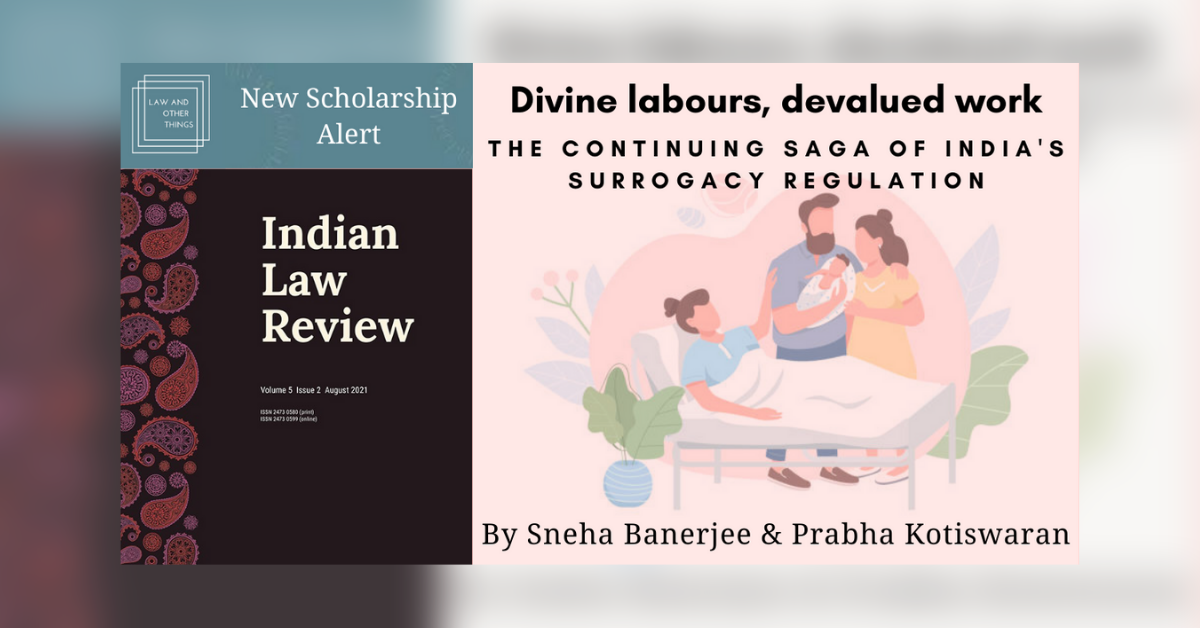[Ed Note: As part of our New Scholarship section, we have been inviting discussants to respond to the public law themed articles featured in Volume 5 the Indian Law Review. You can access all the posts in this discussion here. In this post, our editor Eeshan Sonak introduces the arguments made by Profs. Sneha Banerjee and Prabha Kotiswaran in their paper titled “Divine labours, devalued work: the continuing saga of India’s surrogacy regulation”. You can access the article here. This discussion comes in the backdrop of the Parliament’s winter session, where it is hoped the Surrogacy (Regulation) Bill will be discussed.]
In this article, Sneha Banerjee and Prabha Kotiswaran offer a feminist critique of the Surrogacy (Regulation) Bill, 2019, arguing that it reflects a limited understanding of the complexities of surrogacy, is discriminatory in its approach, is plagued by lack of clarity, is unrealistic and does not include adequate safeguards for the surrogate. They note that women’s reproductive labour in performing surrogacy is valorized but not compensated, and conclude that in its current form, the Bill is vulnerable to challenge on constitutional grounds.
Introduction
Surrogacy is a desirable opportunity for family formation, while simultaneously being a maelstrom for a range of ethical issues. For feminists in particular, surrogacy presents a formidable challenge. On the one hand, it queers compulsory heteronormativity and the heteropatriarchal family-form while on the other, generating exploitative arrangements for surrogates in the global South as reproductive markets present favourable economic terms and bargaining power for intending parents from the global North. Correspondingly, the law has become a site for intense political, social and economic contestation over the status of women’s reproductive labour.
Banerjee and Kotiswaran’s position on surrogacy regulation mirrors the materialist feminist approach wherein surrogates are understood as subject to the twin forces of capitalism and patriarchy. They recognize that women undertake surrogacy under highly unequal conditions of capitalist patriarchy, but do not find it exceptional in relation to a range of other forms of gendered reproductive labour like sex work or unpaid domestic work done by housewives, such that it warrants exceptional treatment by the state. They acknowledge power differentials, constrained choices and exploitative relations shaped by a globalized context and believe that women’s agency in wanting to become surrogates for a fee cannot be dismissed as false consciousness. Lastly, they are opposed to prohibitionism and blanket bans, which are oblivious to the lived realities of surrogates and instead focus on how law can ensure economic justice for them.
Regulatory landscape of surrogacy in India
India is probably one of the few countries in the world to have adopted every possible regulatory approach to surrogacy in the space of fifteen years. An early attempt was made by the Indian Council of Medical Research (ICMR) in 2005, and thereafter, separate chapters on surrogacy were included in the various versions of the Draft Assisted Reproductive Technologies (Regulation) Bill (ART Bill) proposed between 2008 and 2013. These laws were liberal in their regulatory approach towards ARTs and surrogacy. Between 2012 and 2016, however, the proposed laws became increasingly restrictive. The proposals went from being highly favourable to fertility clinics (and less so to surrogates) to severely restricting actors who could avail of ART on the basis of marital status, sexual orientation and nationality/ citizenship with correspondingly increasing levels of protection to surrogates.
The Surrogacy (Regulation) Bill, 2016, which sought to prohibit commercial surrogacy and permit only altruistic surrogacy under limited conditions, was referred to a Parliamentary Standing Committee (PSC) which recommended the reversal of almost every key feature of the 2016 Bill. The PSC proposed a “compensated” model for surrogacy over an altruistic form and stated that surrogates did not have to be close relatives of the intending parents. The 2016 Bill lapsed with the dissolution of the 16th Lok Sabha, but was re-introduced and passed as the 2019 Bill without incorporating any recommendations of the PSC report. When the 2019 Bill was introduced and debated in the Rajya Sabha, numerous MPs expressed their reservations to this Bill, and so it was referred to a Select Committee of the Rajya Sabha (RSC). The RSC reiterated many of the PSC’s recommendations, however, it upheld the Bill’s approach of allowing only altruistic surrogacy thus rejecting both commercial and compensated surrogacy.
Against this backdrop, Banerjee and Kotiswaran critique the 2019 Bill to ensure non-discrimination, equality of access to surrogacy and economic justice for surrogates.
Surrogacy and ARTs
The Bill and the ART Bill are complementary legislations in various ways, and passing the Bill in the absence of the ART Bill can lead to confusion and ambiguity. Banerjee and Kotiswaran point out some of the glaring gaps in the Bill such as its failure to define the term “Assisted Reproductive Technology”. They also note that registration requirements must be aligned with corresponding provisions of the ART Bill, and suggest that the ART Bill should be introduced prior to this Bill. They also contend that conditions for egg donation or the number of attempts the surrogate mother can be subjected to are more appropriately subjects within the ART Bill. Lastly, they argue that the Bill does not provide the child with a right to know the identity of the surrogate mother, and does not include adequate safeguards for the children born of surrogacy like addressing what happens when such a child is abandoned.
Restrictive Eligibility Criteria
To limit the ethical use of surrogacy to compelling circumstances or ‘medically indicated’ cases, the law must lay down eligibility criteria for those who may be allowed to use it – delineating physiological as well as social parameters. The Bill, however, lays down highly restrictive eligibility criteria for intending parents and surrogates. It requires either spouse to be infertile and excludes conditions such as the absence of a uterus or other medical conditions that prevent carrying a pregnancy to term. Moreover, the Bill permits only heterosexual, married couples to commission surrogacy.
Banerjee and Kotiswaran question the basis on which a heterosexual married couple is considered to be inherently more capable of being a parent and forming a family compared to a single person or cohabiting couple or same-sex couple. They argue that this classification is not founded on intelligible differentia and does not have any rational nexus with regulating surrogacy. Therefore, they conclude that the Bill falls foul of Article 14 of the Constitution.
Next, they argue that the Bill violates reproductive autonomy, dignity and right to privacy under Article 21. It fails to satisfy the three-point test of restrictions on the right to privacy set out by Justice Chandrachud in the Puttaswamy decision. They argue that requiring altruistic surrogacy in the absence of compensation for women’s reproductive labour and without corresponding protections for the surrogate under the Bill amounts to an unreasonable and disproportionate encroachment on the surrogate’s reproductive autonomy. Using gender stereotypes that naturalize women’s reproductive labour as divine ignores the structural inequalities that mediate a surrogate’s performance of such labour. They conclude that the Bill reinforces these stereotypes while paying lip-service to addressing structural inequalities.
Beyond altruistic vs. commercial surrogacy: “compensated surrogacy” and the prevention of exploitation
Since all surrogacy arrangements are ultimately contractual in nature, Banerjee and Kotiswaran at the outset point to the oddity in the Bill having no mention of contract at all. A provision that spells out the rights and duties of each party, namely the intending couple and the surrogate mother is extremely necessary in this regard. They argue that only reimbursing costs or expenses incurred is not sufficient in lieu of the time and effort that the surrogate devotes to the process. Compensation is a better way of recognizing their contribution than mere exaltation.
Banerjee and Kotiswaran also argue that uncompensated surrogacy is likely to violate Article 23 of the Constitution. Indian courts have in various contexts acknowledged that the act of bearing a child is reproductive labour. In decisions such as the Baby Manji case and Jan Balaz case, contracts for commercial surrogacy were not held to be illegal thus offering implicit recognition of the reproductive labour of surrogates. However, to make a case for unconstitutionality under Article 23, unremunerated surrogacy must amount to begar or forced labour. Banerjee and Kotiswaran draw from Justice Bhagwati’s decision in PUDR v. Union of India where he concludes that any factor which deprives a person of a choice of alternatives may properly be regarded as ‘force’.
In a patriarchal society such as India, families exert considerable power over the lives and reproductive decisions of women. If close relatives of the intending couple, especially their sisters-in-law or other daughters-in-law of their family are persuaded to act as surrogates, they are likely to experience significant levels of pressure and might even be coerced. With no payment allowed for in the Bill, these women will be performing reproductive labour for less than the minimum wage attracting the application of Article 23. Admittedly, compensation is not an antidote to coercion but as the Supreme Court has noted, coercion is endemic, whether in the labour market or in marriage, and compensation can keep impermissible levels of exploitation at bay.
Criminalizing surrogacy
A heavily criticized aspect of the Bill is its excessive reliance on criminalization to prevent commercial surrogacy. Banerjee and Kotiswaran note that these punishments are disproportionately high when compared to punishments in surrogacy laws around the world. They argue that the high level of criminalization under the Bill is consonant with the Indian state’s efforts over the past decade to don a paternalist mantle and introduce increasingly carceral laws in the name of promoting gender equality even though the laws themselves have been ineffective at best, often generating unintended consequences (like emergence of illicit black markets) and undermining women’s sexual autonomy and freedom of movement.
Furthermore, the Bill presumes that all surrogates are forced into surrogacy and reverses the burden of proof onto the intending couple. Banerjee and Kotiswaran recognize that this provision can be misused and suggest that section 4(iii)(b) be amended to require the appropriate authority to be satisfied that the surrogate is not compelled into surrogacy before issuing an eligibility certificate.
Conclusion
Banerjee and Kotiswaran end the paper by looking at the global experience of regulating surrogacy. They note that India fell in the category of liberal countries in the initial years but has shifted towards the regulationist and tolerationist approaches in the recent past. They suggest that while making this change, India should consider lessons from other countries because placing high levels of restrictions on surrogacy threatens to export the surrogacy market elsewhere. This would result in only the wealthiest Indians being able to afford surrogacy, leading to a highly inequitable scenario.
Against this backdrop, the recommendations of the RSC on the sheer unworkability of the Bill as passed by the Lok Sabha are very welcome. Yet, in recommending the liberalization of the eligibility criteria while retaining altruistic surrogacy, the RSC’s 2020 report has muddied the regulatory waters yet again. On the one hand, like the proponents of the Bill, the RSC believes that the epitome of Indian motherhood is to reproduce children for the market, with “divine warmth and affection,” irrespective of detriment to the wellbeing of one’s self and family, thus valorizing freely provided reproductive labour. On the other hand, the inclusion of the term “prescribed expenses” leaves the door half open for some form of compensation, especially since the arrangement is not restricted to “close relatives”. Even if the Committee’s suggestions are accepted, expecting the performance of reproductive labour for third parties without payment will raise the presumption that such labour is forced for lack of payment and will therefore violate Article 23 of the Constitution.
Banerjee and Kotiswaran conclude by saying that the 2019 Bill has some glaring omissions which may tie up the Bill in constitutional litigation for years, particularly around issues of discrimination, right to privacy and forced labour, rendering uncertain (once again) the legal landscape for those who harbour the hope of making families through surrogacy.
Dr. Sneha Banerjee is an Assistant Professor at the Department of Political Science, University of Hyderabad. Dr. Prabha Kotiswaran is a Professor of Law and Social Justice at the Dickson Pool School of Law, King’s College London, UK.






Thanks for sharing. I read many of your blog posts, cool, your blog is very good.
Thanks for sharing. I read many of your blog posts, cool, your blog is very good.